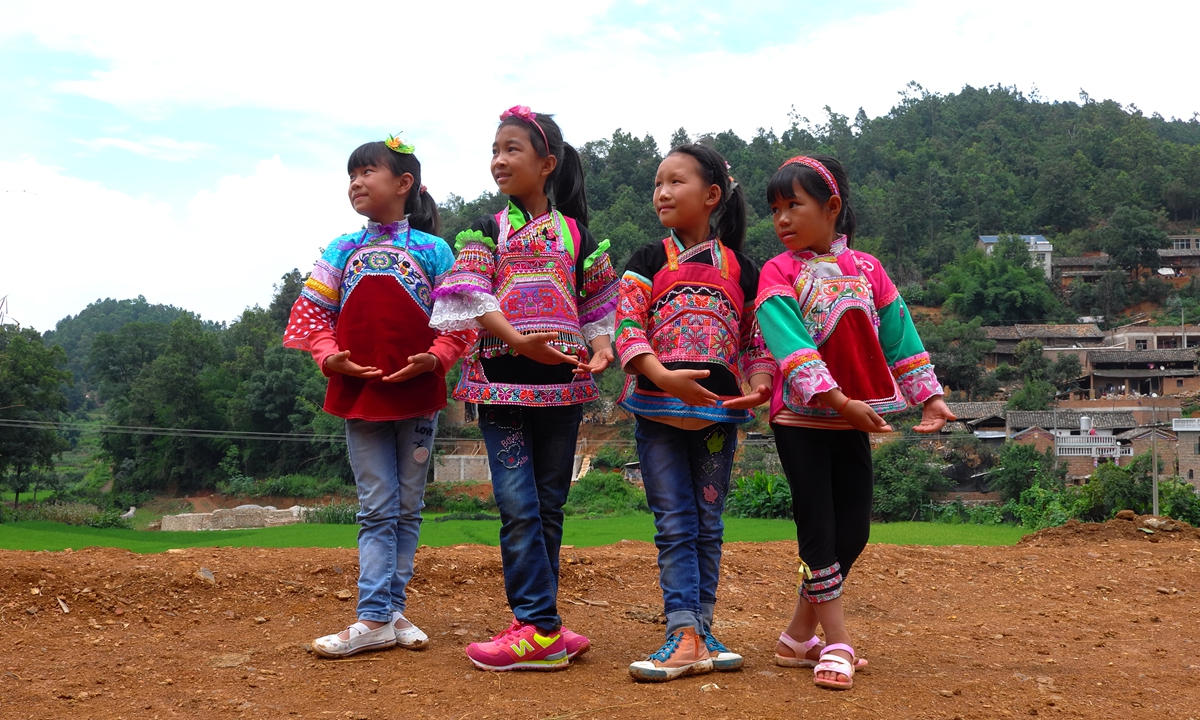
Zhang Ping teaches a dance class for children in Naaduo village, Yunnan Province. Photo: Courtesy of Guan Yu
A green tent pitched on red earth is beset by a sudden rainstorm. While rain water quickly accumulates and forms several pockets of water on the tent, a line of children within the tent place a foot on a bamboo pole tied to a tree as they warm up for dance practice.
This is just another ordinary day for many children of the Yi ethnic group living in Naaduo village, a once poor mountainous village in Southwest China's Yunnan Province. The group practices basic dance moves under the instruction of Guan Yu and Zhang Ping, a couple from Beijing.
Since 2016, Guan, who teaches dance at the Beijing Dance Academy, and his wife Zhang, a well-known choreographer, have carried out the public welfare project Naaduo Art, which aims to teach dance to children from poor families so that they may have access to greater opportunities in the future.
The project has brought classes to more than 30 local villages and sent 88 children from ethnic minorities, including the Zhuang, Miao and Yi, to art schools in Yunnan.
Two students who graduated from the program in 2021 were respectively recruited by Minzu University of China and the Yunnan Arts University.
As the project matured and benefited more children, Guan and Zhang also witnessed how rural areas were improved through government-backed poverty alleviation efforts.
"There were no hard-surface roads in these areas, but now asphalt roads pass through them all and my foreign friends who are interested in our project can conveniently come here and join us," Guan, who is now in Yunnan, told the Global Times.
The paths of possibility
Naaduo is a typical rural village where the children and elderly have been left behind as young adults head to big cities to earn a living.
In many cases, their absence has led to a failure to pass on ethnic culture.
Zhang visited Naaduo, one of China's most impoverished villages at the time, for the first time in 2016. The living conditions of the children shocked her.
Zhang had to enter the village by foot as her car was unable to navigate the single mud road leading into the village.
Many left-behind children had to carry out heavy housework after school and some had even dropped out of school altogether.
Zhang told her husband that she wanted to help change these children's lives, a decision that Guan gave his firm support.
To persuade the children's parents and grandparents to their kids to learn dance, they spent a lot of time on home visits and explained the positive effects dance can bring.
They found that many children were living with their grandparents as they were either left-behind children or orphans.
In 2019, the couple established the Naaduo Voluntary Center for Public Welfare in the village to better carry out the project.
The expanding volunteer group is made up of more than 30 members from all walks of life.
Guan noted that all volunteers participate at their own expense. Coming from different fields and academic backgrounds, they have all devoted themselves to exploring the future development of ethnic minority children in remote mountainous areas and coming up with feasible plans to improve the environment of ethnic minority villages from various perspectives.
Children learn diverse styles of dance at the beginning and after they become familiar with basic skills, the couple picks a style that they have a talent for and help them further improve their skills in this area.
The couple have choreographed traditional dances related to Yi culture for these children, some of whom have performed them on TV for audiences around the country. The project has also brought children to major metropolis such as Beijing, giving them a broader look at life.
Cultural exchange
Some overseas volunteers from places such as the US and South Korea have taken part in the project.
Guan recounted a time when children of a family from the Netherlands danced and farmed the fields together with children in the village.
Guan said he saw this as a type of cultural exchange as these volunteers taught English to the children, while he encouraged them to learn the Yi language and experience local life and culture.
"Chinese culture is rooted in rural areas. For example, yangge is a folk dance that was originally performed to celebrate the harvest in villages of Northeast China. This art was born on the muddy land of rural areas, and I want to bring it back to its birthplace and show it to the world," Guan said.
Many other Chinese dancers are also stepping forward to help ethnic minorities.
Dong Jilan, a post-1990s Bai ethnic dancer from a mountainous village in Yunnan, told the Global Times that she was recruited by the dance troupe of Yang Liping, one of China's most famous folk dancers and also a member of the Bai ethnic group, at the age of 11 when Yang visited her hometown to recruit students.
When she first entered Yang's dance troupe, she knew nothing about the art form. But after years of practice, she has made a name for herself on the international stage by becoming the first dancer from the Chinese mainland to be nominated for the Emerging Artist Award at the UK's National Dance Awards 2018 for her dance show Whip, which emerged from the womb of traditional Bai dance.

Yi ethnic group children demonstrate their ballet moves in Naaduo village, Yunnan Province, in 2016. Photo: Courtesy of Guan Yu





